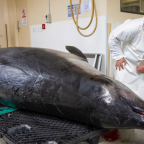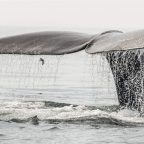
It’s been a tough start to summer for the endangered North Atlantic right whale. Six were found dead last month in the Gulf of St. Lawrence, off Canada. Their deaths are prompting ocean officials to call for a swift response to protect the remaining 400 or so whales that are left. Part of this response came Monday night. Canadian officials announced protective measures for the right whale, including reduced ship speeds and increased aerial surveillance in the Gulf of St. Lawrence.
Patrick Ramage is the director of marine conservation for the International Fund for Animal Welfare (IFAW). Ramage is in Washington D.C. this week with IFAW, brainstorming for ways to better protect right whales. He spoke with WGBH Radio’s Judie Yuill about the plight of the North Atlantic Right Whales. This transcript has been edited for clarity.
Judie Yuill: North Atlantic right whales are endangered. Six deaths in one month — that’s more than 1 percent of the entire population. Are there any estimates on how many deaths the North Atlantic right whale species can sustain while still maintaining a stable population?
Patrick Ramage: We’re either at or beginning to move beyond the point of no return. And what I mean by that is, the best scientists in the world who are studying this problem assure us that unless the current trend lines are meaningfully altered, both in the mortalities of these animals and in an alarmingly low birth rate, that within five years, we might be in a situation where the animal is functionally extinct.
Yuill: How many right whales die on average in waters in this area, and why are so many dying now?
Ramage: It varies year to year. In 2017, there was really a nightmare of a year, where 17 right whales were killed. That was followed with a double whammy, really, because in the warm waters off of Florida and Georgia where these animals have their young, no births were recorded in calendar year 2018. Those two factors in combination really put pressure on the right whale population to survive.
Yuill: Officials say it appears that three of the whales were killed by ship strikes. So what role does human activity play in right whale deaths overall?
Ramage: These animals aren’t dying of old age. They’re dying because we’re killing them. The threats that these whales face in modern times are collisions with ships, ocean noise pollution, which, for these animals, threatens their ability to communicate, breed and feed.
Part of the reason for the dramatic increase in recent years in deaths is these animals are spending more and more time further and further north in their range in order to get to their food source. As a result of that lengthened migration, they are exposed to more and more threats. Unfortunately, the changes in open ocean temperature in the North Atlantic, which are changing the migratory patterns and distributions of all kinds of marine species, are posing a real threat to this whale as it moves into waters not previously in its range, or at least not in recent years. And we’re having to accelerate regulatory efforts and modifications of gear and shipping lanes in order to reduce the threat.
Yuill: What else is being done to protect the remaining members of the species?
Ramage: Voluntary actions being taken by shipping companies, and measures put in place by ports up and down the East Coast in U.S. and Canadian waters are helping mitigate the threat of ship strikes. We’ve also been pleased to partner with the National Oceanic and Atmospheric Administration (NOAA) to develop an app called Whale Alert, which is designed to give mariners on the bridge of a ship a real-time sense of where right whales have been heard or sighted. The other challenge, as I mentioned, is entanglement in fishing gear. Government regulators are putting in place measures to reduce the number of vertical lines. Those are important first steps, but ultimately, gear innovations, including very promising developments of ropeless fishing gear, are some of the most promising approaches to remove completely the deadly threat of more than a million vertical lines strewn across the ancient migratory pathway of this critically endangered species.














Social Profiles